Ateliers Jean Nouvel completed Louvre Abu Dhabi in in 2017 in Abu Dhabi, United Arab Emirates. The Concept Design phase for the Louvre Abu Dhabi project took place between 2006 and 2007. The Design Development phases followed in 2007 to 2012 and the construction of the museum from 2013 to 2017. Prior to the completion of the museum, the Louvre Abu Dhabi has already been the recipient of three international awards.
The museum and the seaAll climates like exceptions. Warmer when it is cold. Cooler in the tropics. People do not resist thermal shock well. Nor do works of art. Such elementary observations have influenced the Louvre Abu Dhabi. It wishes to create a welcoming world serenely combining light and shadow, reflection and calm. It wishes to belong to a country, to its history, to its geography without becoming a flat translation, the pleonasm that results in boredom and convention. It also aims at emphasizing the fascination generated by rare encounters.
It is rather unusual to find a built archipelago in the sea. It is even more uncommon to see that it is protected by a parasol creating a rain of light.
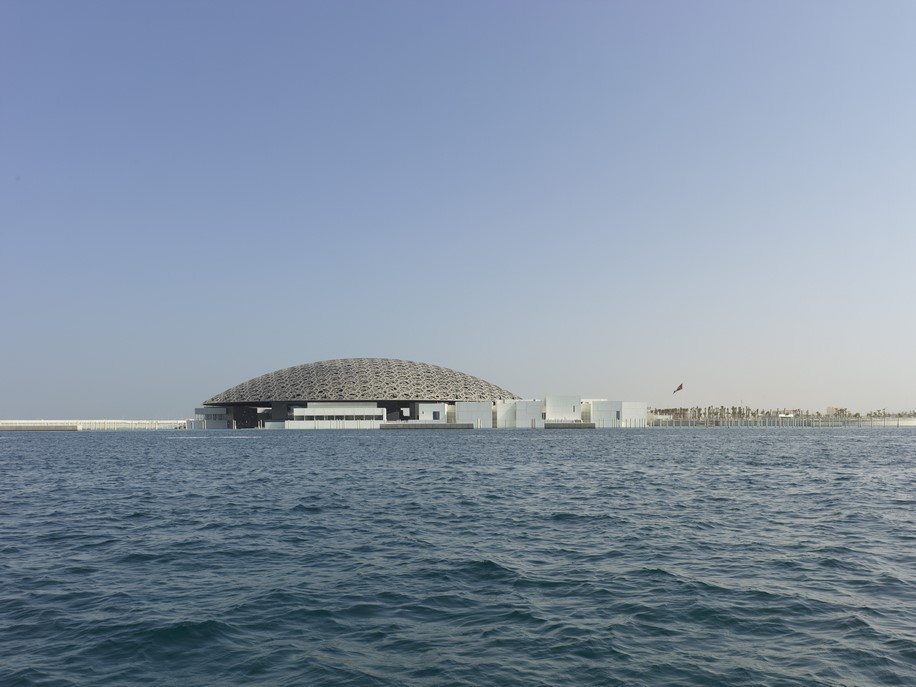
The possibility of accessing the museum by boat or finding a pontoon to reach it by foot from the shore is equally extraordinary, before being welcomed like a much-awaited visitor willing to see unique collections, linger in tempting bookstores, or taste local teas, coffees and delicacies.
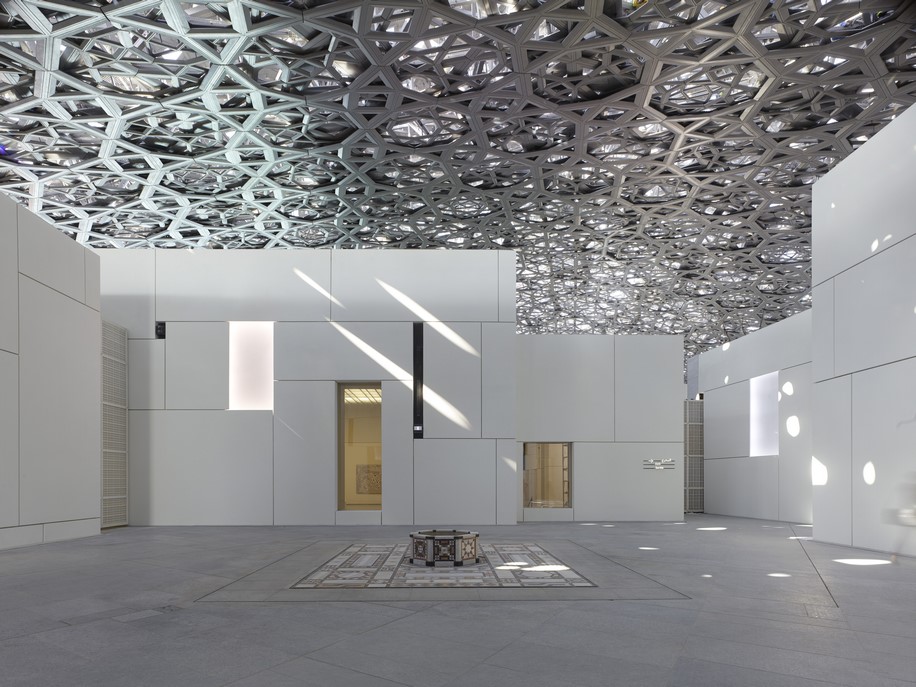
It is both a calm and complex place. A contrast amongst a series of museums that cultivate their differences and their authenticities.
It is a project founded on a major symbol of Arab architecture: the dome. But here, with its evident shift from tradition, the dome is a modern proposal.
A double dome 180 metres in diameter, offering horizontal, perfectly radiating geometry, a randomly perforated woven material, providing shade punctuated by bursts of sun. The dome gleams in the Abu Dhabi sunshine. At night, this protected landscape is an oasis of light under a starry dome.
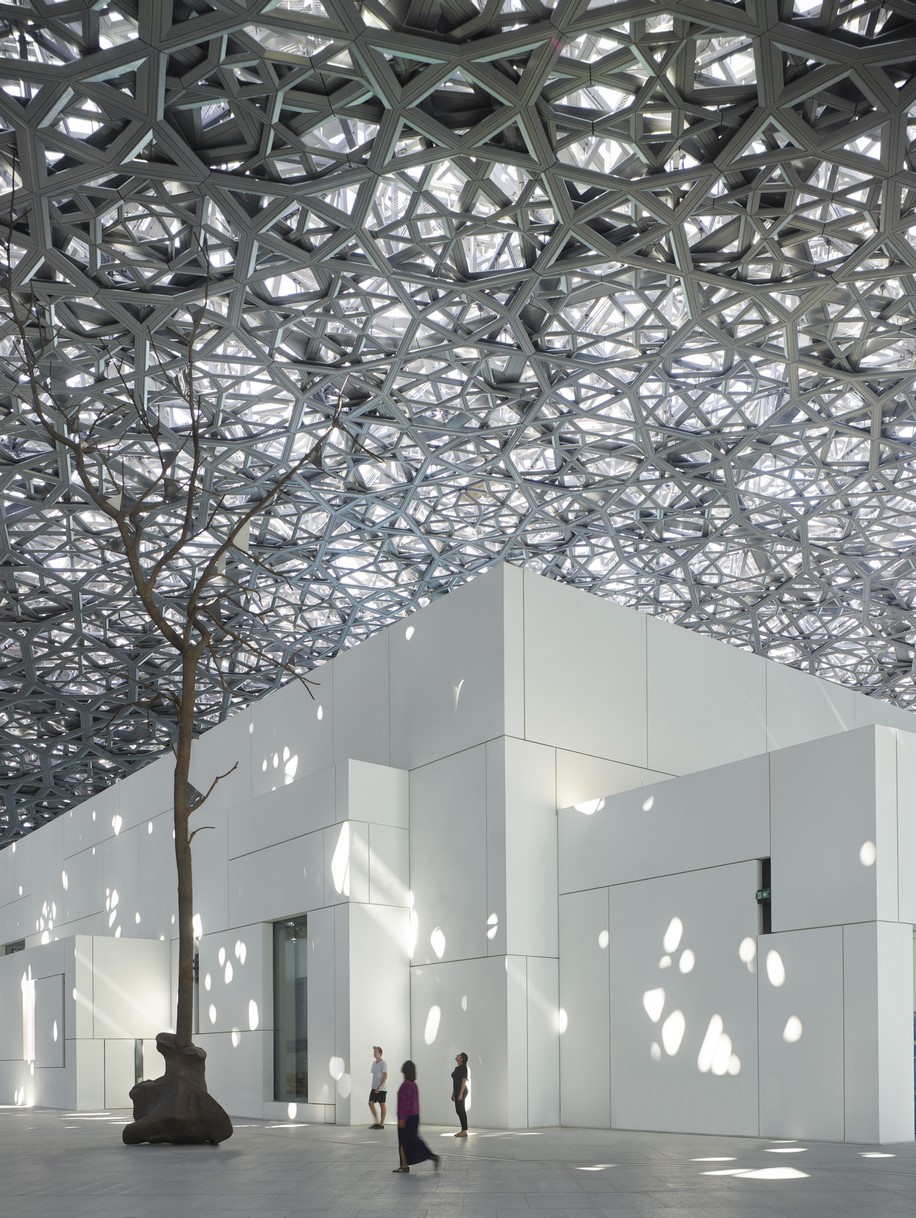
Jean Nouvel sought inspiration for the concept of Louvre Abu Dhabi in traditional Arabic architectural culture.
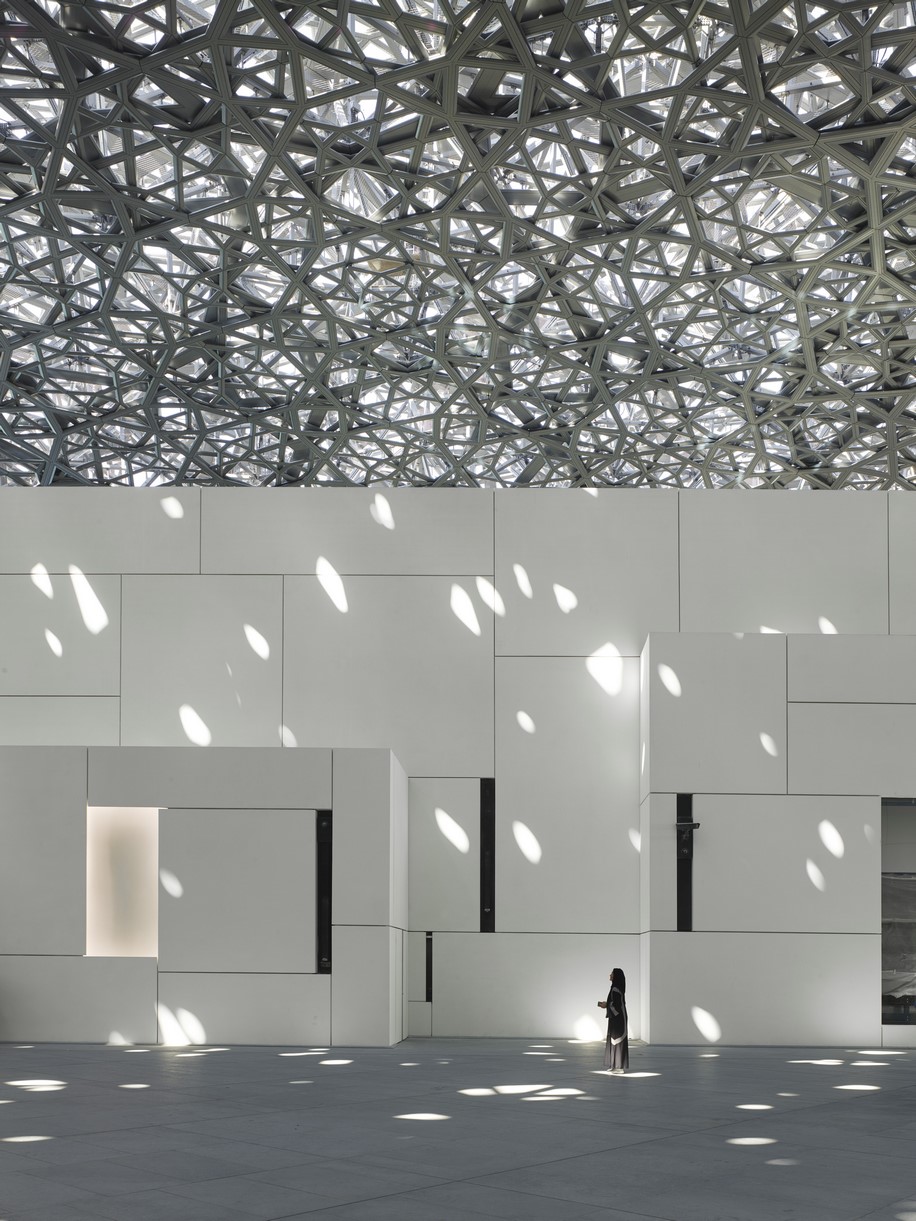
Louvre Abu Dhabi becomes the final destination of an urban promenade, a garden on the coast, a cool haven, a shelter of light during the day and evening, its aesthetic consistent with its role as a sanctuary for the most precious works of art.
Jean Nouvel
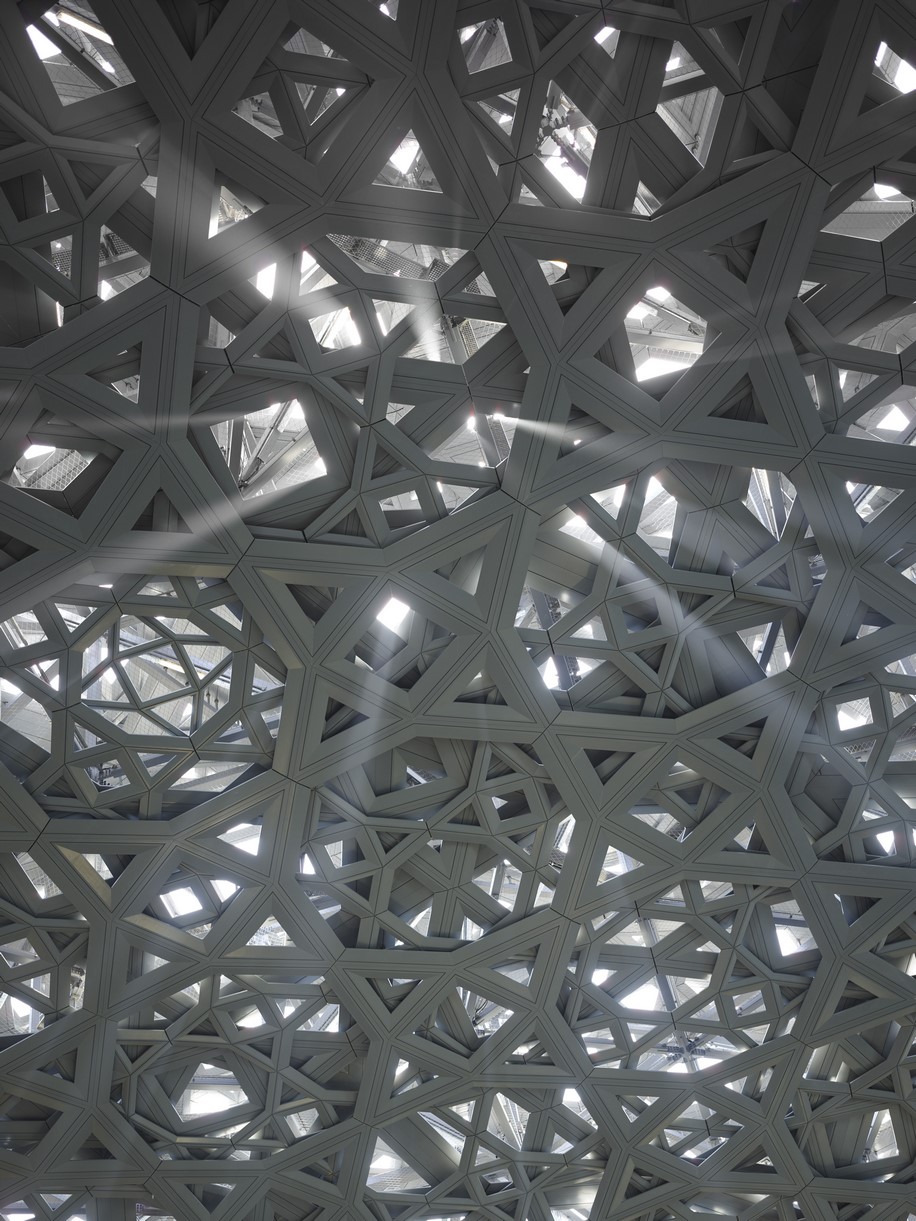
Design
Pritzker-prize winning architect Jean Nouvel sought inspiration for the concept of Louvre Abu Dhabi in traditional Arabic architectural culture. Taking a contextual approach to the site, Nouvel designed Louvre Abu Dhabi as a ‘museum city’ in the sea. Its contrasting series of white buildings take inspiration from the medina and low-lying Arab settlements. In total, 55 individual buildings, including 23 galleries, make up this museum city. The façades of the buildings are made up of 3,900 panels of ultra-high performance fibre concrete (UHPC).
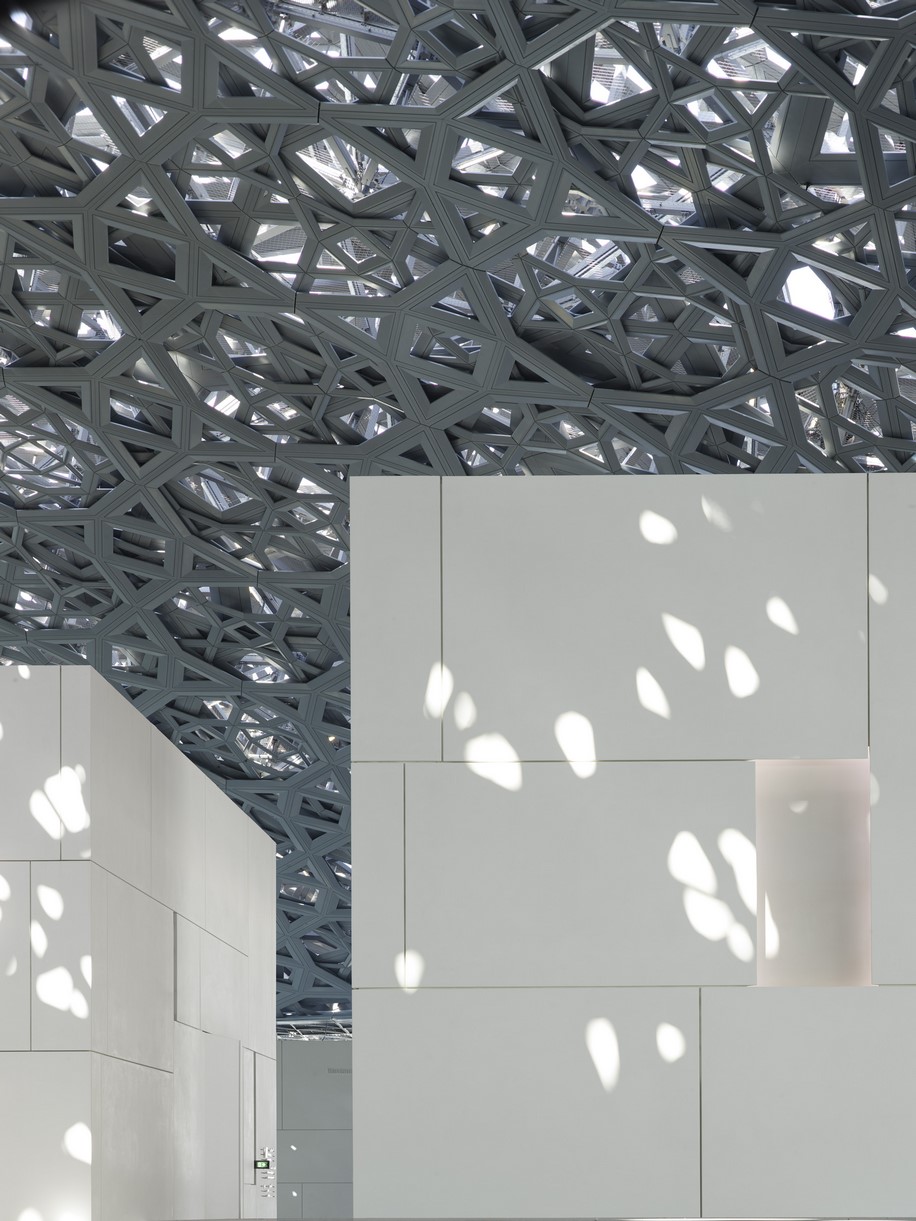
A vast dome, 180 metres in diameter, covers the majority of the museum city and is visible from the sea, the surrounding areas and Abu Dhabi city. This dome was constructed by the Austrian company Waagner Biro who specialize in steel structures. The dome consists of eight different layers: four outer layers clad in stainless steel and four inner layers clad in aluminium separated by a steel frame five metres high. The frame is made of 10,000 structural components pre-assembled into 85 super-sized elements, each weighing up to 50 tonnes.
The dome’s complex pattern is the result of a highly studied geometric design. It involved close collaboration between the architectural design team at Ateliers Jean Nouvel and the structural engineers at BuroHappold Engineering. The pattern is repeated at various sizes and angles in the eight superimposed layers. Each ray of light must penetrate the eight layers before appearing then disappearing. The result is a cinematic effect as the sun’s path progresses throughout the day. At night, it forms 7,850 stars visible from both inside and out.
Named the ‘rain of light’, this effect has been the subject of many models and mock-ups over the years and is one of the defining features of the concept.
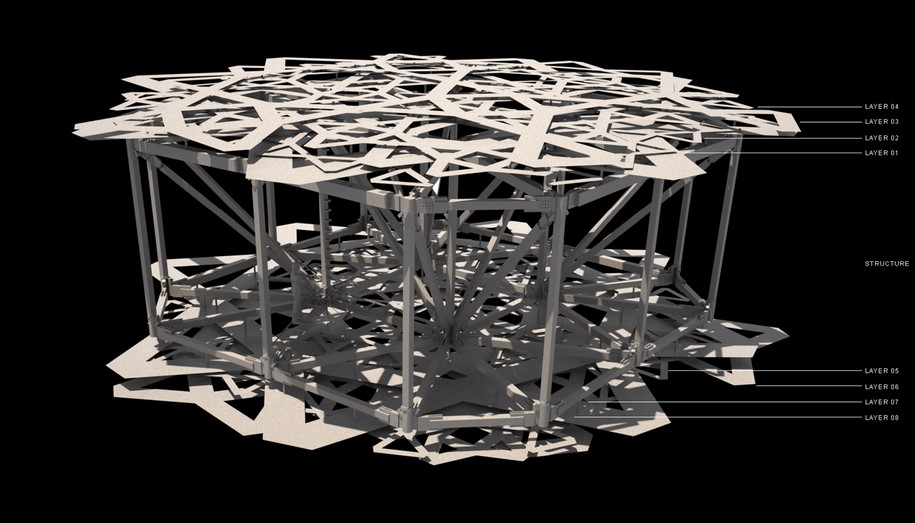
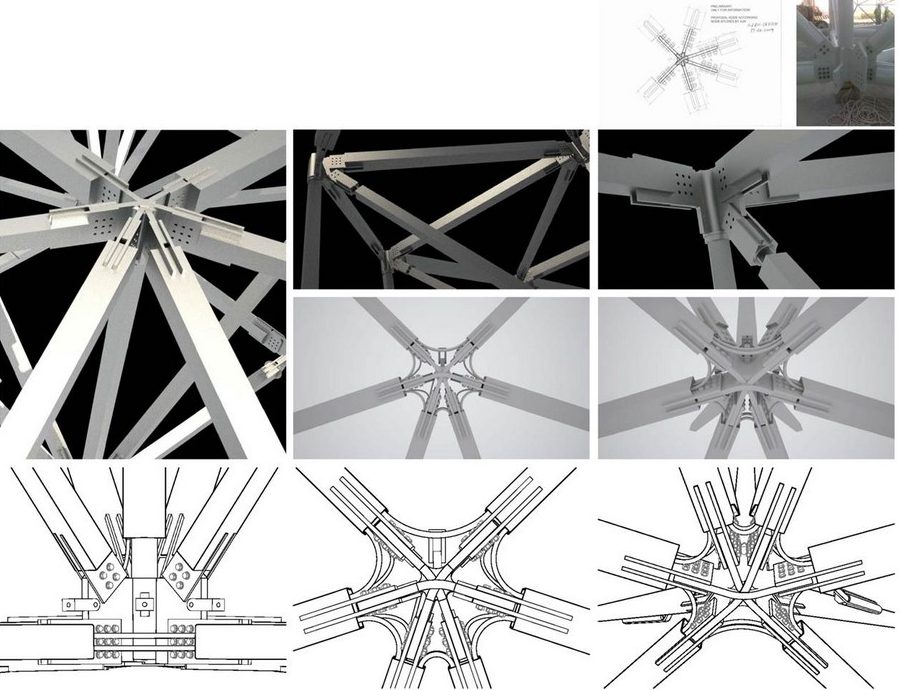
The dome is supported by only four permanent piers, each 110 metres apart. These are hidden within the museum buildings to give the impression that the dome is floating. The interior dome elevation is 29 metres from the ground floor to the underside of the cladding. The highest point of the dome is 40 metres above sea level and 36 metres above ground floor level.
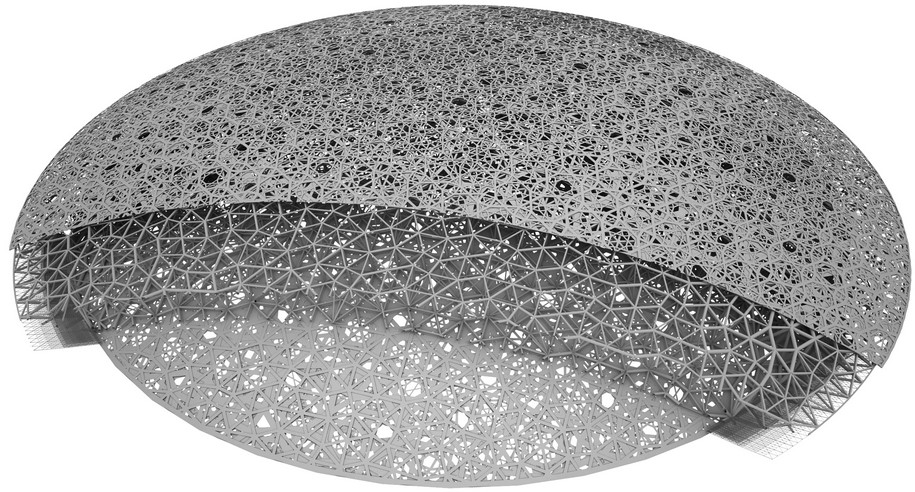
The complex engineering concept made Louvre Abu Dhabi one of the most innovative and challenging museum projects to be built in recent times.
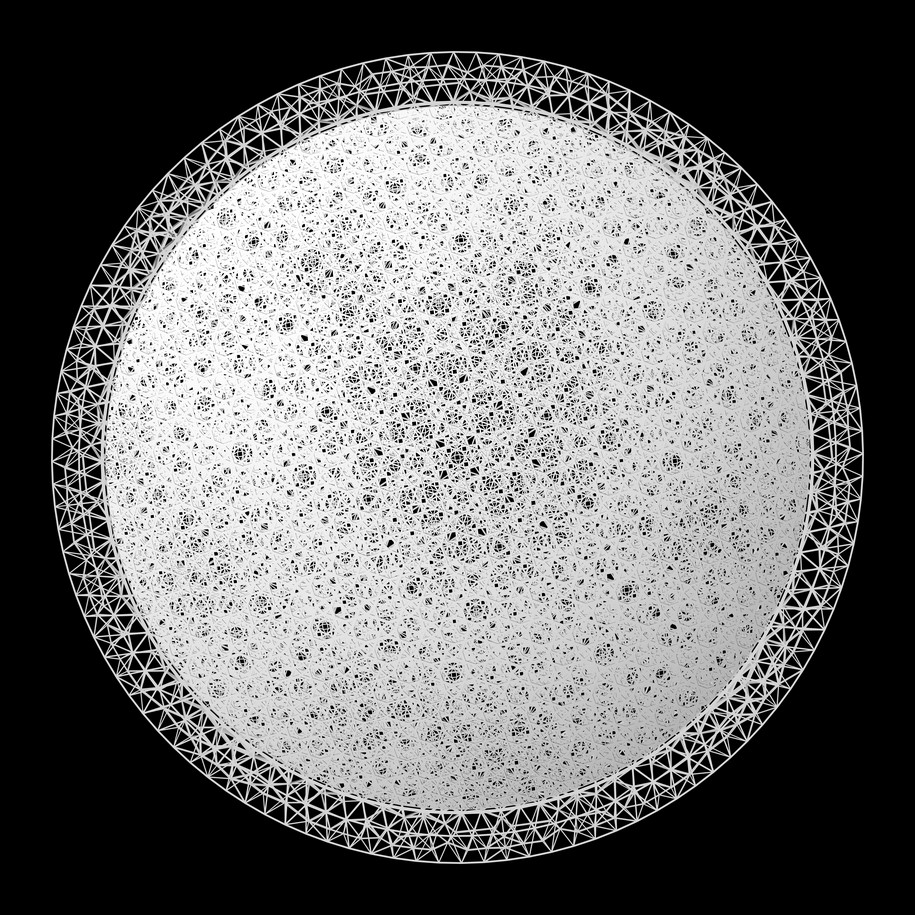
The museum design is a collaboration between traditional design and modern construction techniques. The tranquil environment encourages visitors to enjoy the ever-changing relationship between the sun and the dome and between sea, buildings and land. The complex engineering concept made Louvre Abu Dhabi one of the most innovative and challenging museum projects to be built in recent times.
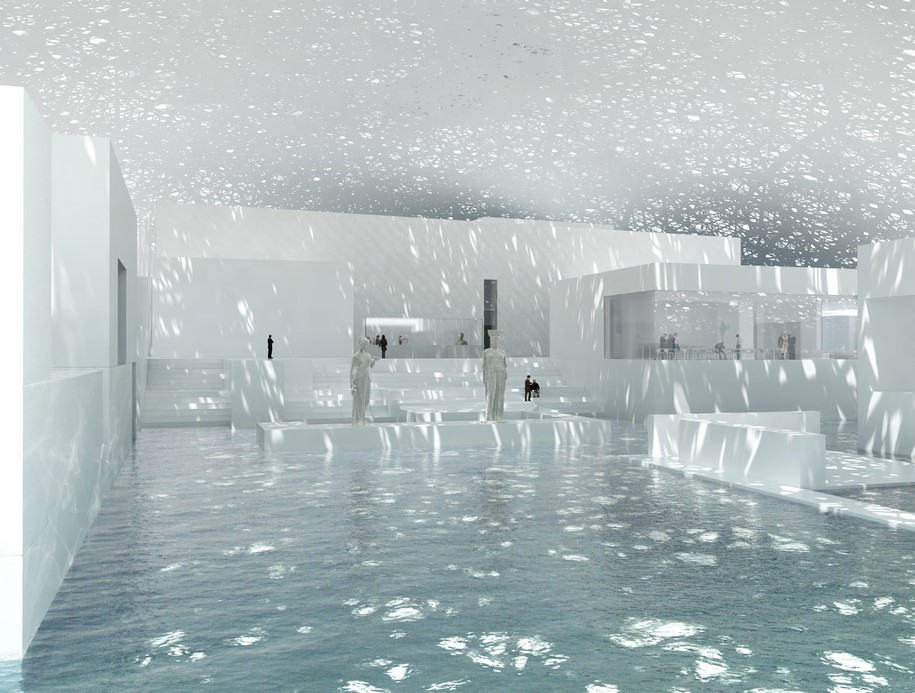
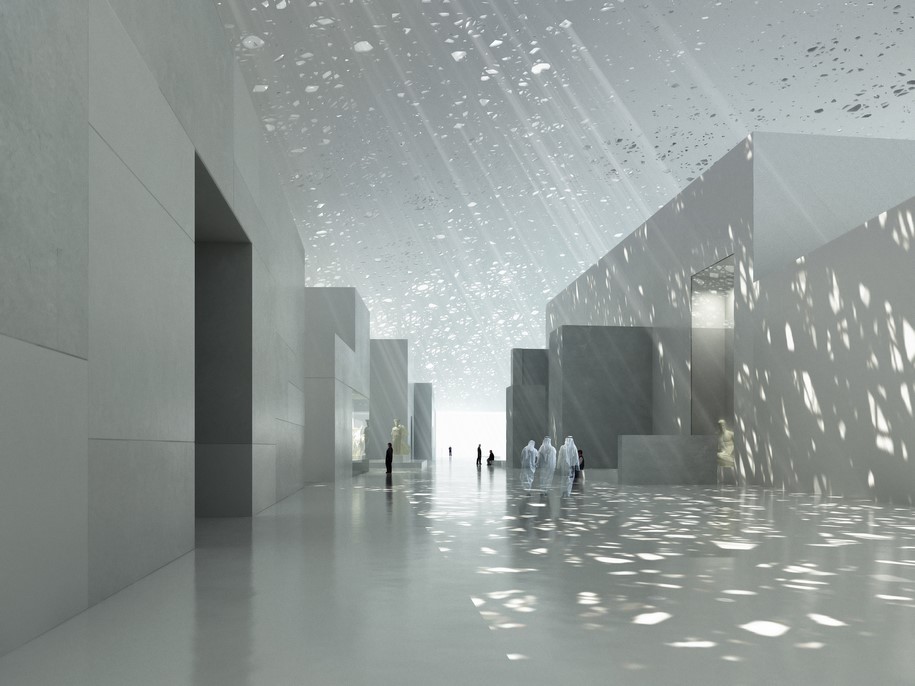
The Concept Design phase for the Louvre Abu Dhabi project took place between 2006 and 2007.
The Design Development phases followed in 2007 to 2012 and the construction of the museum from 2013 to 2017. Prior to the completion of the museum, the Louvre Abu Dhabi has already been the recipient of three international awards: winner of the ‘Project of the Future’ category of the Identity Design Award in 2015; the European Steel Design Award in 2017, received with Waagner Biro, the Louvre Abu Dhabi dome specialist, and winner of the ‘Most Prominent UAE Project’ category of the Identity Design Award in 2017.
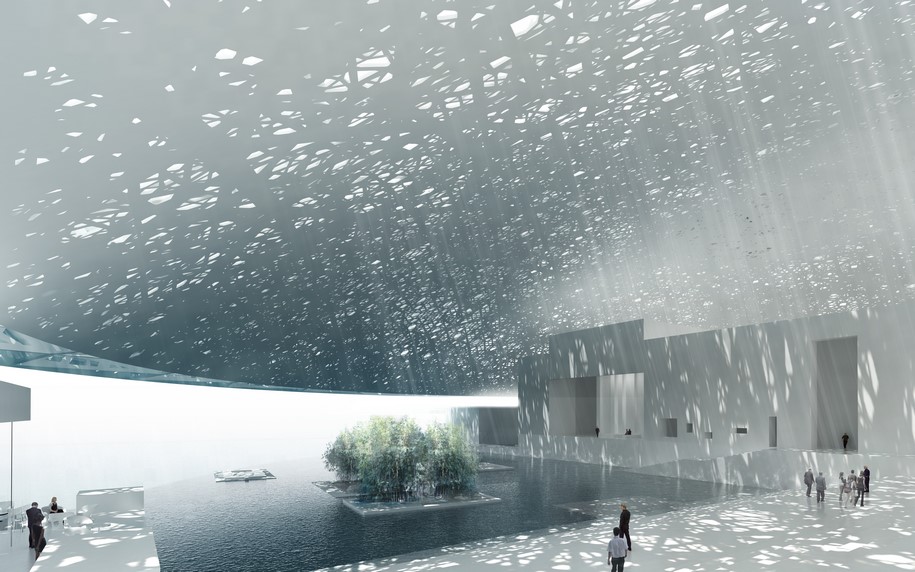
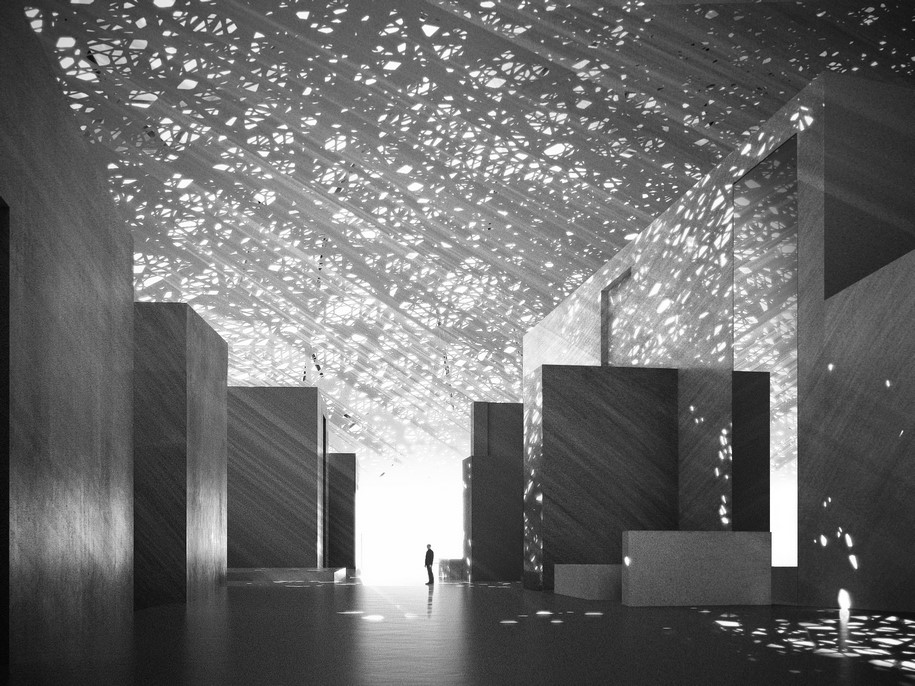
Interior exhibition spaces
The interior exhibition spaces, comprising museum galleries, temporary exhibition spaces and Children’s Museum, make up 8,600 square metres. The museum galleries incorporate approximately 6,400 square metres and showcase approximately 600 artworks. The two-stories-Children’s Museum completes the ensemble with approximately 200 square metres specially laid out for Louvre Abu Dhabi’s youngest visitors.
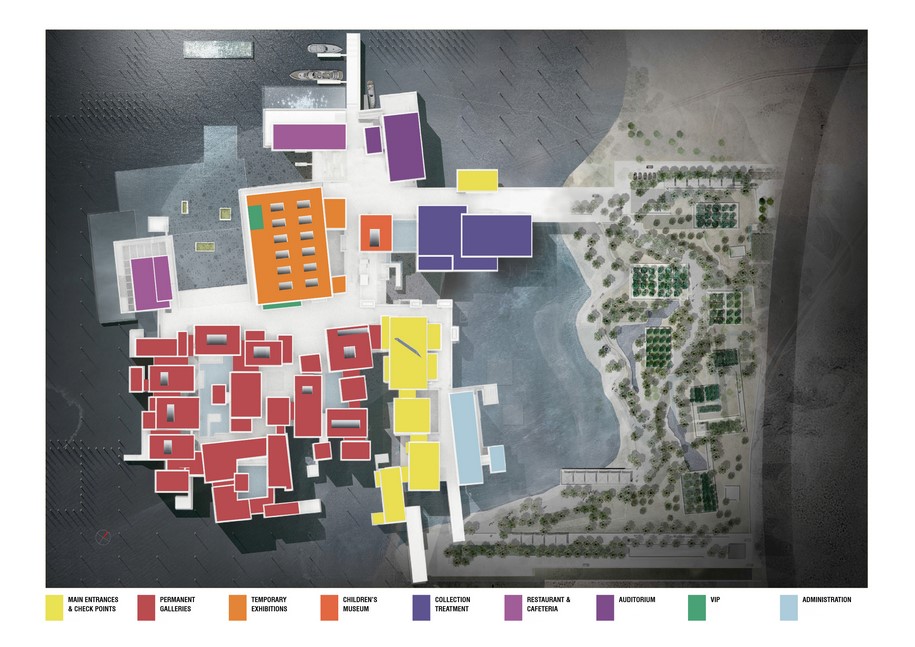
Museum galleries
Specially designed by Ateliers Jean Nouvel, the floors, walls and ceiling surfaces of the museum galleries re-enforce the palatial dimensions of Louvre Abu Dhabi. The floor paving is made of stone modules framed in bronze: throughout the galleries, the choice of stone responds to the period of the artworks on show. The walls provide hanging flexibility: all subsidiary equipment may be concealed within special wall slots.
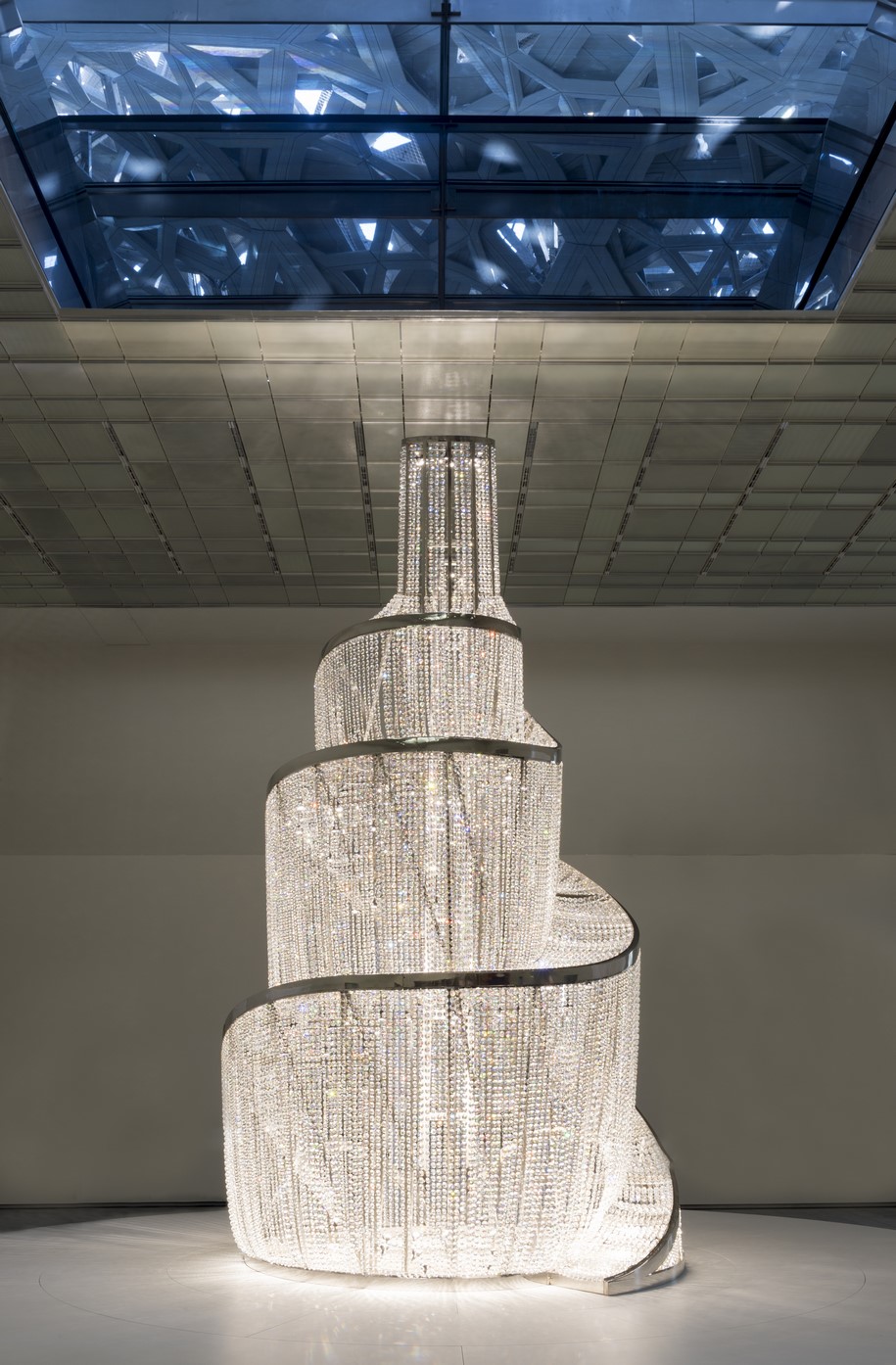
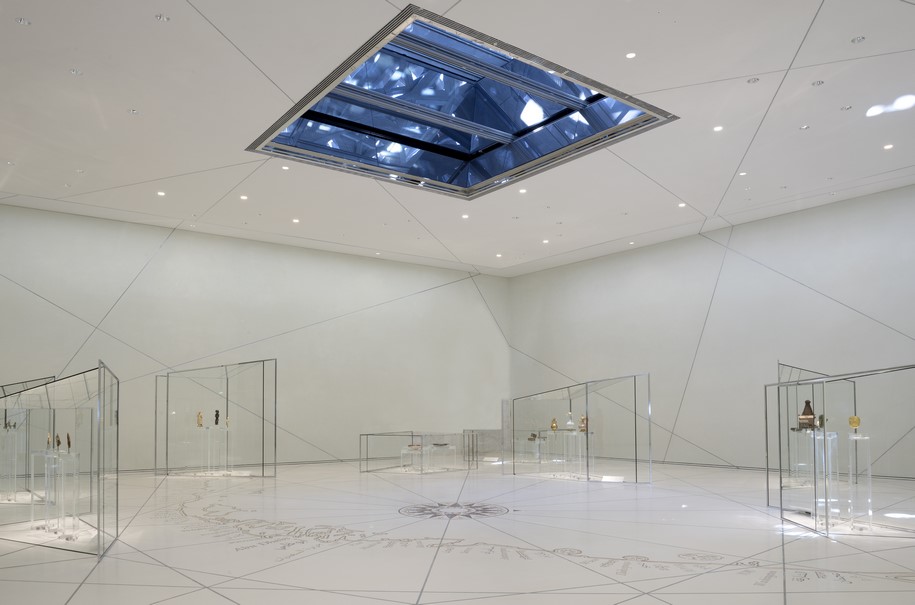
Filtered natural light can be present in all the galleries, either from lateral windows with views onto the surrounding environment or through zenithal lighting.
This involves the use of glass mirrors to capture sunlight and direct it into the gallery spaces while also scattering rays to avoid glare. There are 17 glass ceilings within the museum galleries. Each is made up of 18 different types of glass panels. In total, there are over 25,000 individual pieces of glass. These glass ceilings incorporate both natural and artificial lighting to provide an optimal lighting system for the artworks on display.
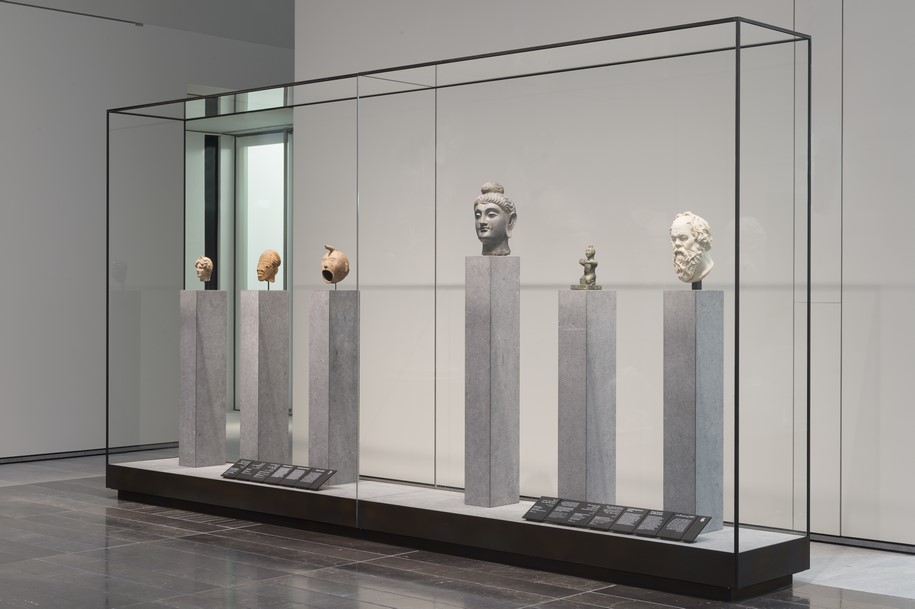
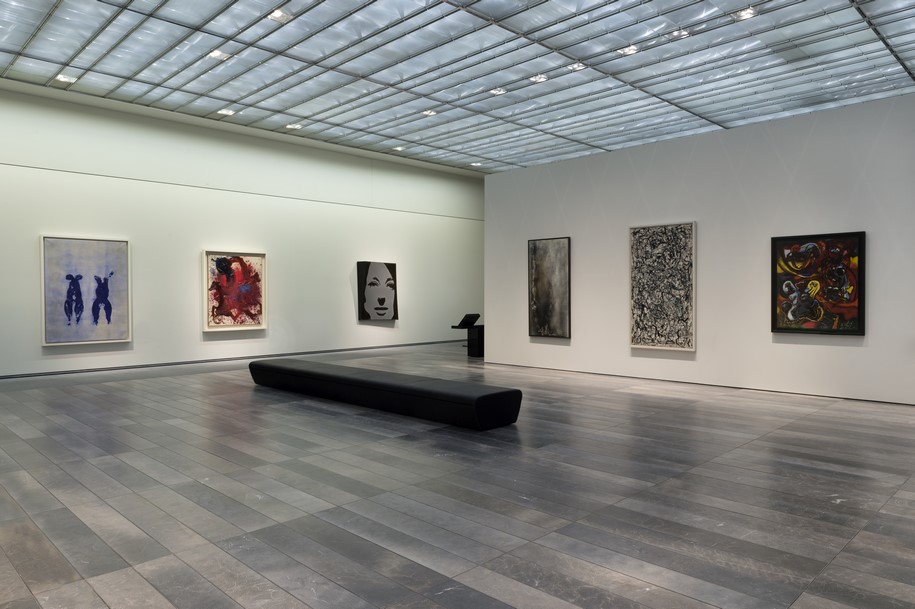
The display cases were also specifically constructed by Meyvaert in Ghent, Belgium for Louvre Abu Dhabi. They incorporate state-of-the art materials and have been designed to adapt flexibly to the rotation artworks on display.
To meet stringent environmental control requirements within the museum galleries, the design team developed a system which cannot deviate by more than one degree from 21 degrees centigrade or 5% humidity range. This guarantees exceptionally stable environmental conditions for artworks and visitors. Fire detection and suppression systems within the galleries require special measures in order to avoid damage to the artwork.
Exterior artwork commissions
Louvre Abu Dhabi has commissioned two internationally acclaimed artists to create site-specific artworks in harmony with the iconic building. Giuseppe Penone and Jenny Holzer have worked closely with Louvre Abu Dhabi’s team and Jean Nouvel to develop sculptures and installations that reflect the universal stories of the museum. These are the first of a number of scheduled commissions for Louvre Abu Dhabi.
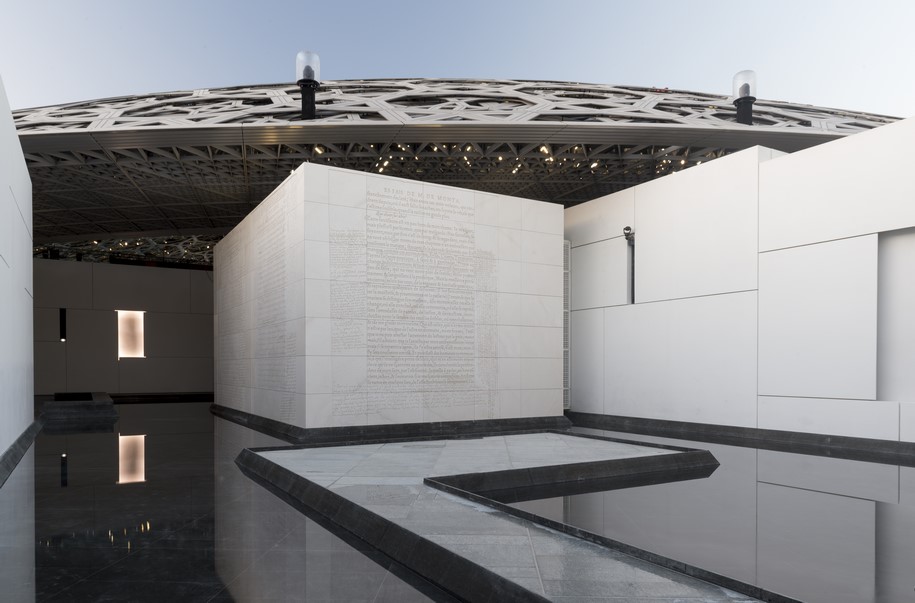
Restaurant
Designed by Ateliers Jean Nouvel, the restaurant at Louvre Abu Dhabi is made up of modular compartments. The intricate interior design takes inspiration from Arabic patterns, which have been engraved into Corian panels. The furniture, also designed by Nouvel, complements the light-filled interiors and panoramic views of the sea. Seven bespoke chandeliers, designed by Jean Nouvel and constructed by Mobilier national, hang over the seven VIP tables.
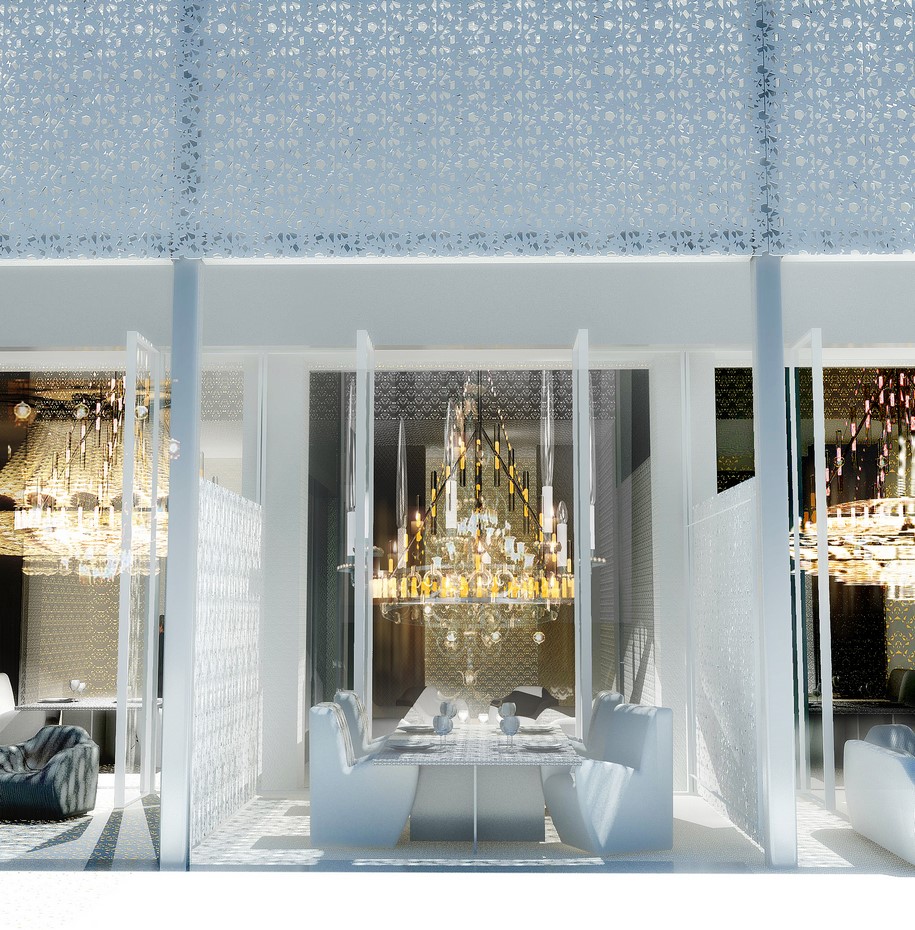
Café
Jean Nouvel’s design for the museum café is inspired by the Op Art (optical art) movement of the 1960s. From certain positions, the café seems entirely monochrome (white); from others, the café interiors are full of colour, like an abstracted reflection of the local maritime environment and port opposite the museum. The floors, walls, ceilings and furniture have been designed specifically for the site by Ateliers Jean Nouvel.

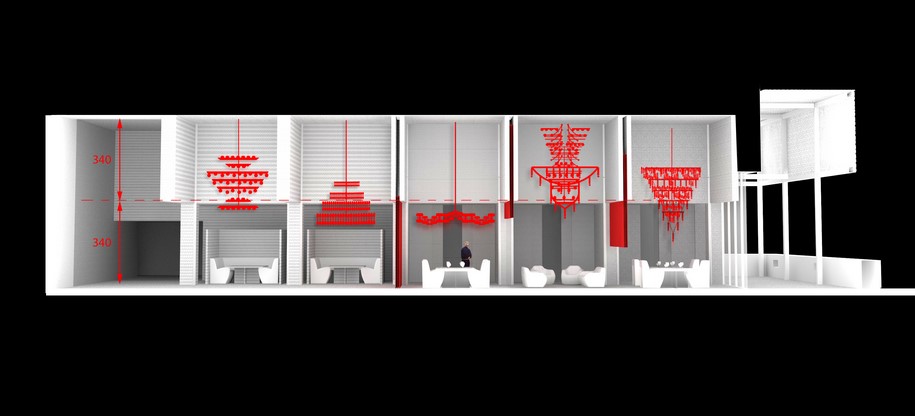
Wayfinding
Philippe Apeloig collaborated with Ateliers Jean Nouvel to design the signage of the museum. Text is in three languages, Arabic, English and French, and implemented in both Arabic and Roman script. Lebanese typographer Kristyan Sarkis created a bespoke Arabic typeface, Louvre Abu Dhabi Arabic, especially for the museum. This new typeface combines the classic Naskh style of Arabic calligraphy with Apeloig’s existing his Colvert Arabic font. For the Roman alphabet texts, Apeloig chose Frutiger LT typeface due to its clarity and readability for signage. The design of the pictograms responds to the museum’s architecture, particularly the abstract shapes created by the ‘rain of light’ filtering through the dome’s eight layers. Each pictogram is a combination of several of these shapes, creating silhouettes and objects. He also contributed to design the logotype.
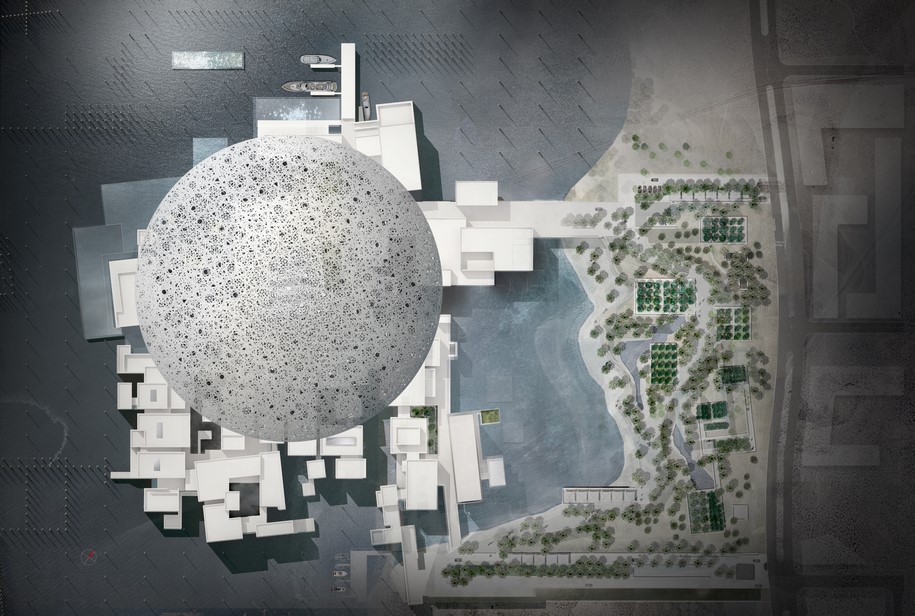
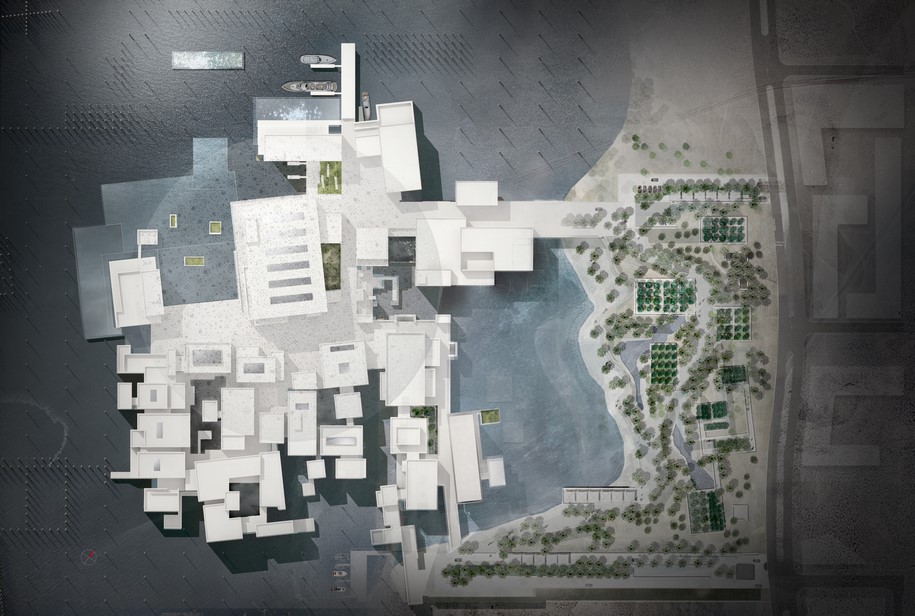
Environmental features
The dome primarily acts as a shading canopy. The dome protects the buildings and outdoor plaza from the heat of the sun, improves comfort for visitors and reduces building energy consumption. This strategy allows visitors to circulate outdoors in a self-regulated ‘micro-climate’ between the museum galleries, exhibitions, Children’s Museum, auditorium, open plaza, café and restaurant. Low-profile but effective passive energy systems naturally enhance the cooling of the buildings and optimise water usage. The design team has also employed passive design techniques to improve sheltered outside conditions. Visitors arriving at the museum and moving under the dome experience a gradual transition from an uncontrolled outside to a controlled inside environment.
Energy and water metering ensures resource efficiency, while leak detection flags any unintended water use.
Louvre Abu Dhabi’s design is targeting a LEED Silver rating and has achieved a 3 pearl Estidama Design Rating.
Flooding of the site
At the beginning of the construction process, the museum was built within a dry dock. Construction of the dry dock began with the installation of a rock embankment, technically known as a revetment. This created a new, temporary coastline on the south-west corner of Saadiyat Island, which was then backfilled using sand pumped from the sea bed.
Piles were then made from mixed-in-place concrete and inserted in an interlocking formation into the island’s bedrock. Together these a hydraulic cut-off wall to protect the structure from the sea.
The process of flooding the site was carried out in four carefully controlled stages and took approximately eight weeks to complete.
Waterproofing
The underside of the basement structure extends up to 15 metres below sea level. Waterproofing was a major design consideration. BuroHappold’s structural engineers designed a watertight concrete box structure surrounded by a double layer of re-injectable waterproof membrane. Further protection against corrosion of the embedded reinforcement is provided by an impressed current cathodic protection system.

Wave breaking and storm proofing
During the design process, BuroHappold’s marine engineers carried out extensive hydrological studies in collaboration with the wave simulation laboratories at Wallingford in the UK.
Louvre Abu Dhabi is protected from the open sea by a number breakwaters, the designs for which were based on the Wallingford studies and which were constructed as part of the marine works sub-contract.
Approximately 280 marine piles as well as concrete breakwaters, tidal pools and a specially designed ‘wearing wall’ system protect the museum from the effects of maritime traffic, the Gulf’s weather and any threats from the sea.
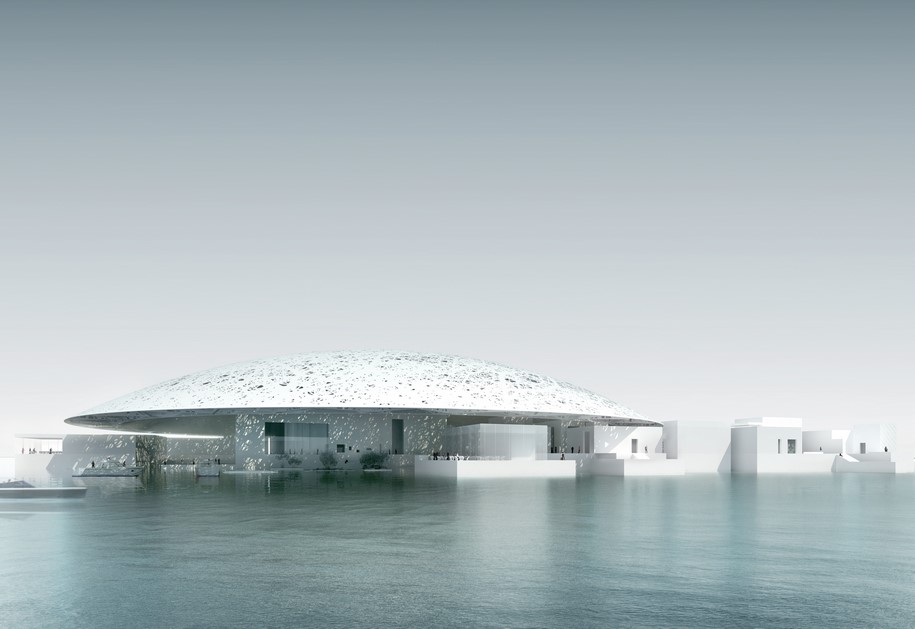
The museum’s wearing wall is made from precast units of ultra-high-performance concrete. Each unit is four metres high and weighs about 10 tonnes. The special concrete material protects the museum from the effects of waves and enables the units to resist outward bending forces. This is a key consideration during a receding tide when rapidly falling water pressure can create a suction-like effect on the museum’s cladding.
The pedestrian plaza is set at four metres above mean sea level. It is equipped with closed balustrades to protect visitors from wave action during severe storms.
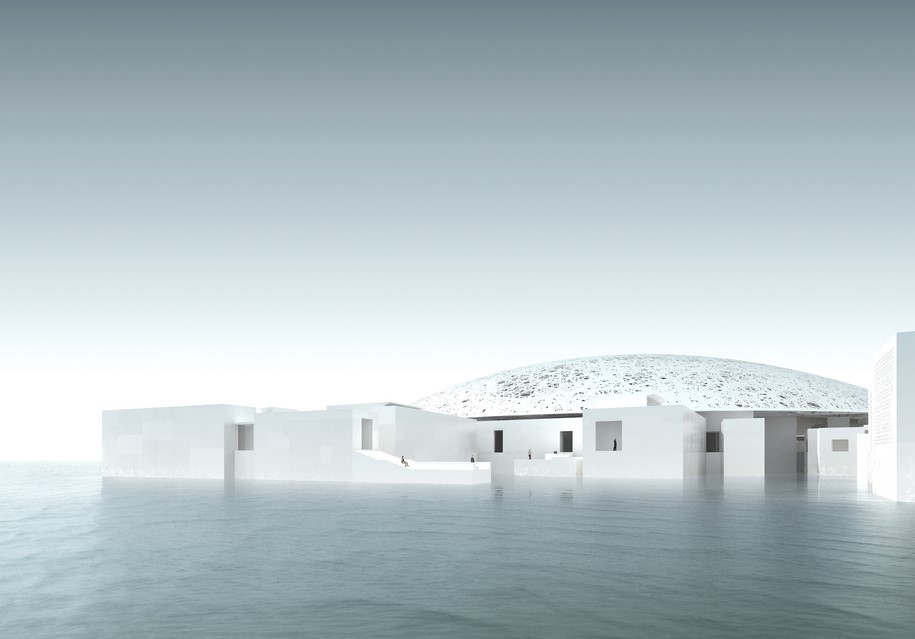
Plans
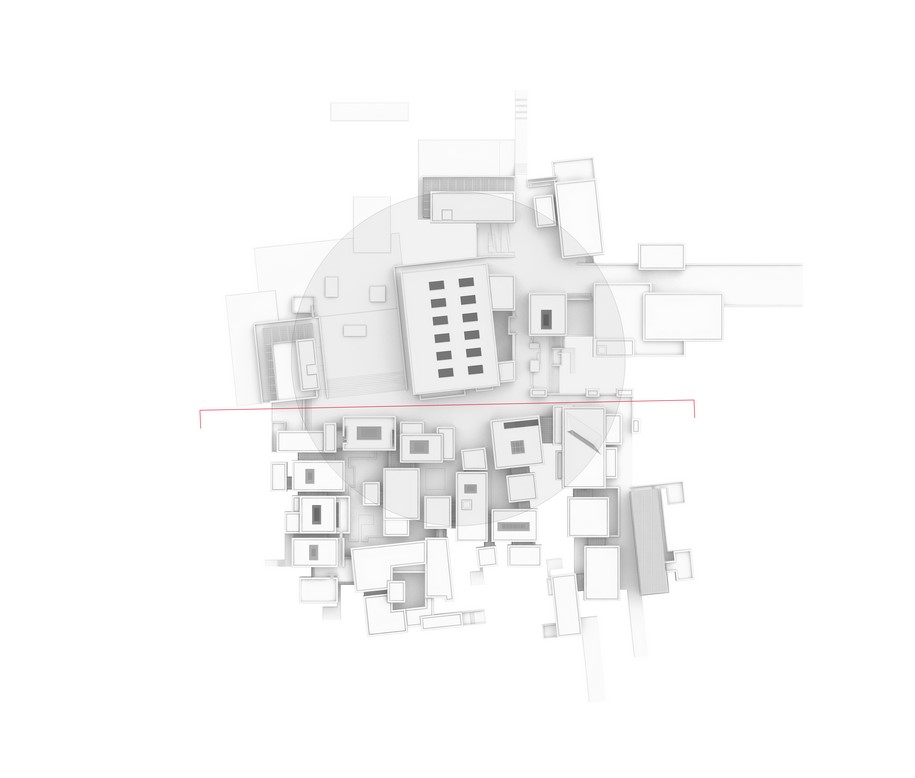
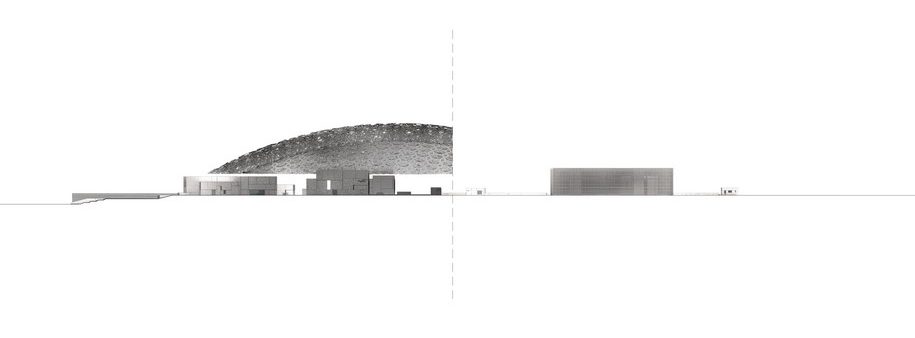
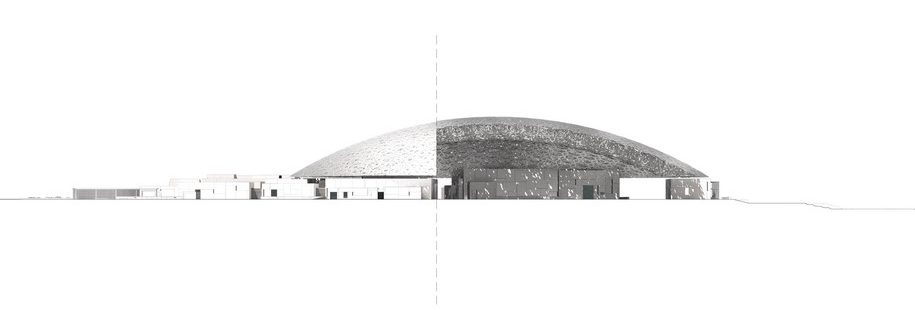
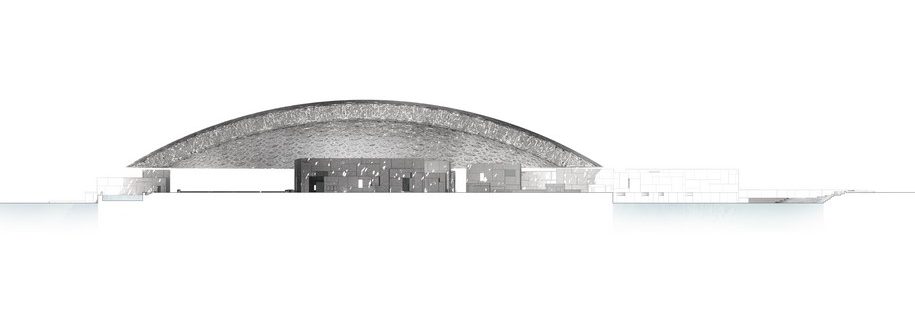

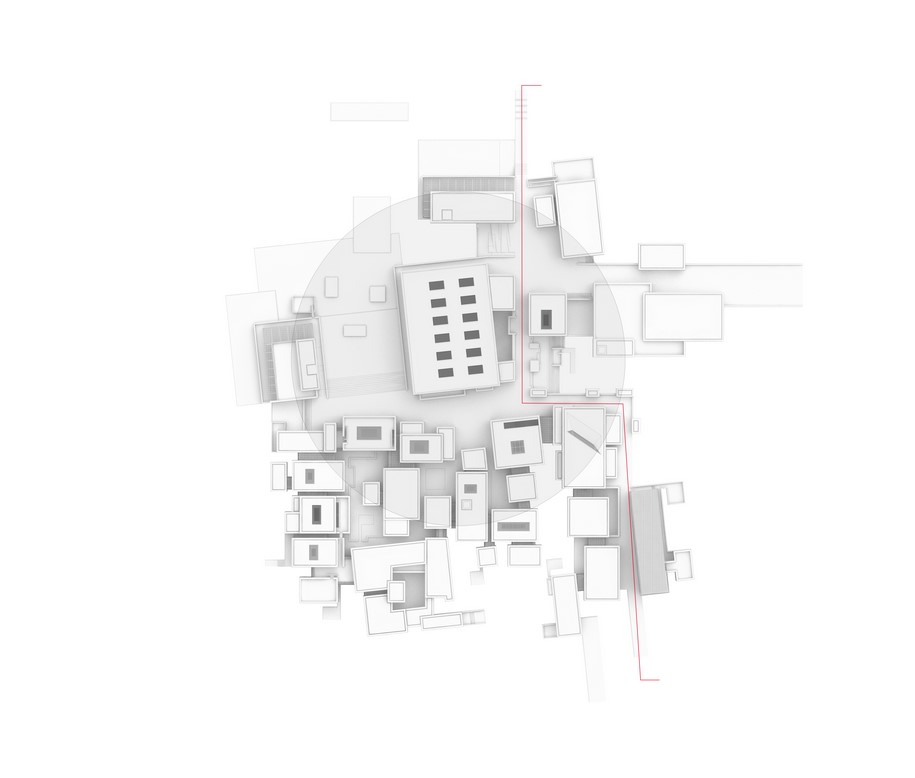
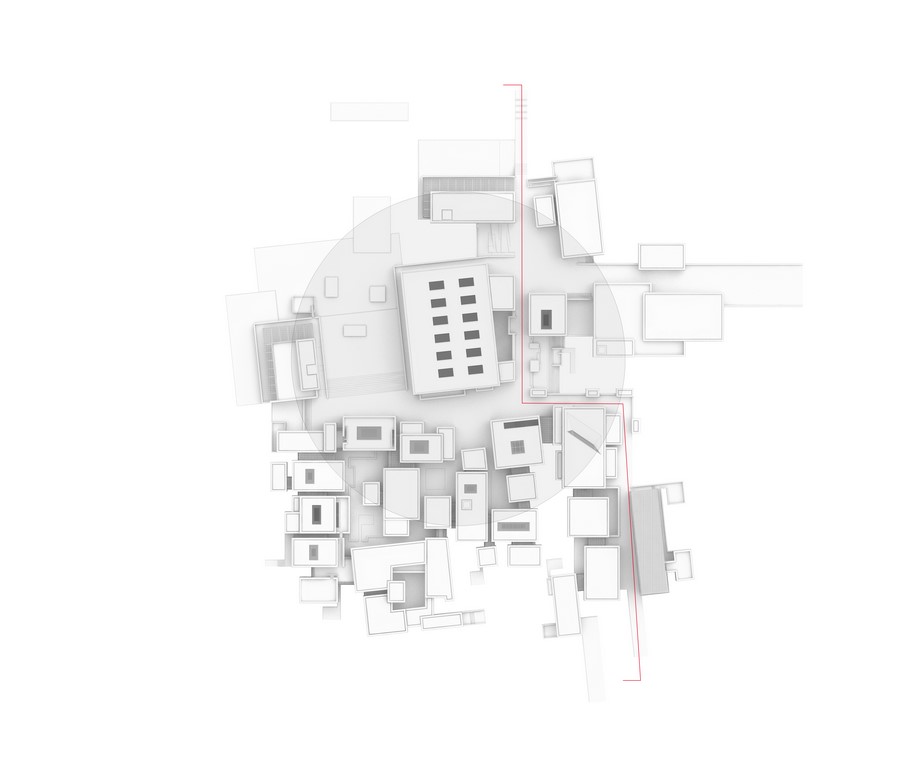
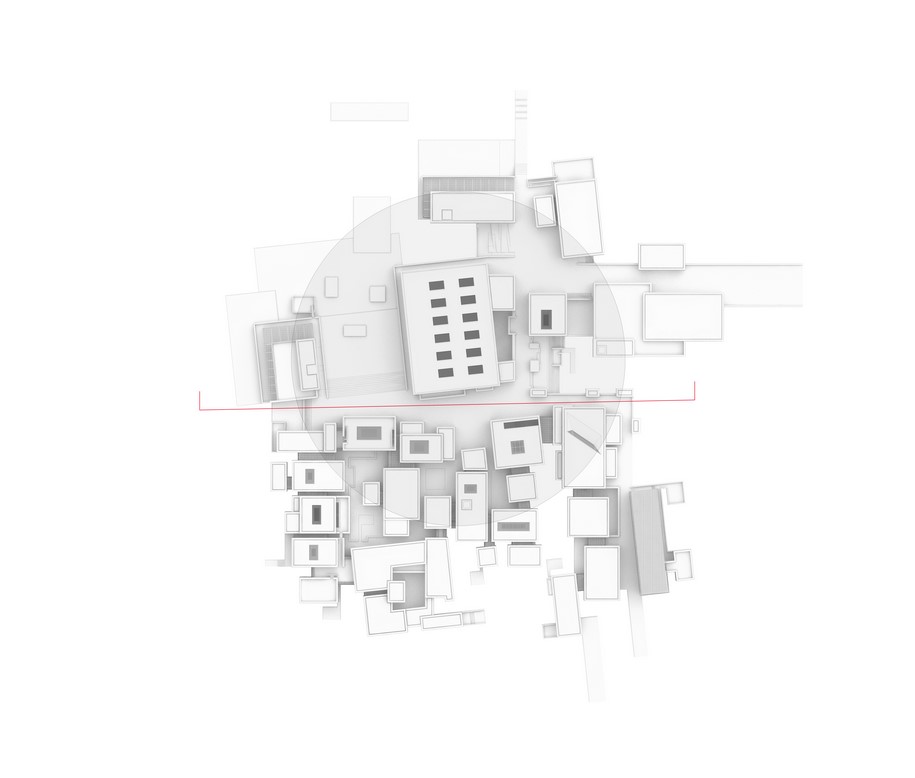
Facts & Credits
Program: Permanent exhibition galleries, temporary exhibition galleries, children’s museum, auditorium, storage, conservation building, restoration workshops, public spaces, administration building, restaurant, café, boutique.
Area: Built up area 97,000 m², All gallery spaces 8,600 m², Permanent galleries 6,400 m², Exhibitions 2,000 m², Children’s Museum 200 m², Auditorium 420 m² / 250 seats
Museum buildings: 55 individual buildings – total, 26 individual buildings – Permanent Galleries
External buildings façade: 3,900 panels (20m² average format) made of ultra-high performance fibre concrete (UHPC).
The dome in figures
- 7,850 unique stars
- Eight layers of cladding
- 180 metre diameter
- 565 metre circumference
- Seven metre width
- 80 mm distance between layers
- 85 super-sized elements weighing on average 50 tonnes
- Highest external point: 40 metres above sea level, 36 metres above ground floor level.
- Interior dome elevation: 29 metres above ground floor level.
- Four permanent piers holding up the dome, 110 metres apart
- Largest stars: 13 metre diameter, 3 tonnes
- 7,500 tonnes in weight – almost as much as the Eiffel Tower
– Dome steel structure: 5,200 tonnes
– Inner and outer cladding, perimeter rim: 2,000 tonnes
– Gratings, walkways, mesh and misc. items: 300 tonnes
- 8% perforation of the dome
- Two years’ total construction time
- Up to 800 workers at a time
Construction contractors: Joint venture between Arabtec Construction LLC, San Jose SA and Oger Abu Dhabi LLC was awarded the project in January 2013.
Louvre Abu Dhabi Design Team
Architect: Jean NOUVEL (Ateliers Jean Nouvel – Paris, FR)
Partner Architect: Hala WARDE (HW architecture – Paris, FR)
Artistic Commision: Jenny HOLZER, Giuseppe PENONE
Project Leaders
Architecture / Interior Design / Museography : Jean-François BOURDET, Anna UGOLINI
Design: Sabrina LETOURNEUR, Frédéric IMBERT
Construction: Damien FARAUT, Athina FARAUT
Senior Architects
Rolando RODRIGUEZ-LEAL, Mireia SALA FONT, Anne TRABAND, Michal TREDER, Natalia WRZASK
Architects
Concept phase: Raphael RENARD, Reda SLAOUI, Youssef TOHME, Qiang ZOU
Design Development phases
Project Managers: Stefan Zopp, Kris GELDOF
Roula AKIKI, Alessandro BALDUCCI, Jessica CALDI, Camille DAUTY, Mark DAVIS, Stacy EISENBERG, Marion FOUCAULT, Steven FUHRMAN, Virginie HECKLE, Stéphanie MENEM, Abel PATACHO, Miguel REYES, Reda SLAOUI, Kathryn STUTTS, Jordi VINYALS, Sébastien YEOU
Construction : Mariam ABUEBEID, Sara AL SAWI, Kelly ANASTASSIOU, Donna ASHRAF, Jessica CALDI, Daniella DE ALMEIDA, Fay EL MUTWALLI, Steven FUHRMAN, Maryam HOSNY, Zaina KHAYYAT, Stéphanie MENEM, Youmna NAJJAR, Miguel REYES
Interior Design: Floriane ABELLO, Lucas DUMON, Isabella GARBAGNATI, Jaiyao HUANG, Tanguy NGUYEN, François ZAB
Computer Renderings: Artefactory (Eric ANTON). Jugulta LE CLERRE, Clément OUDIN, Raphael RENARD
Graphic Design: Rafaelle ISHKINAZI, Marie MAILLARD, Léo GRUNSTEIN, Clovis VALLOIS
Concept Design: ARUP
Schematic Design: BuroHappold, Transsolar
Façades : Andrew SNALUNE
Construction: BuroHappold
Museography: Renaud PIERARD
Graphic design, signage: Philippe APELOIG, Kristian SARKIS
Lighting Design: 8’18”
Scenography, multimedia: dUCKS scéno
Landscape: Michel DESVIGNE, Jean-Claude HARDY
Interior Design: Eric Nespoulous / JND
Acoustics: Studio DAP
Cost Consultant: MDA Consulting
Seismic: Setec
Models: Jean-Louis COURTOIS
READ ALSO: Optical Glass House | Hiroshi Nakamura & NAP